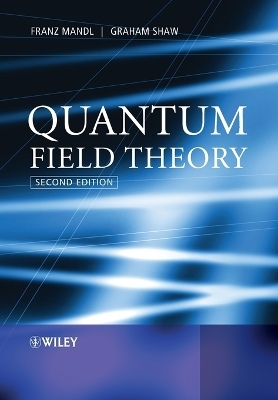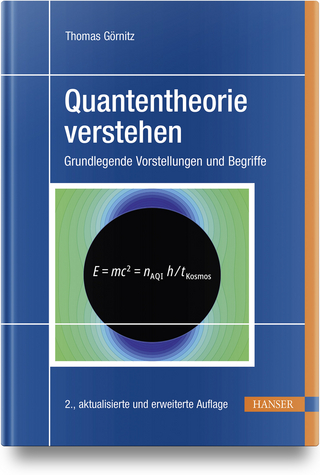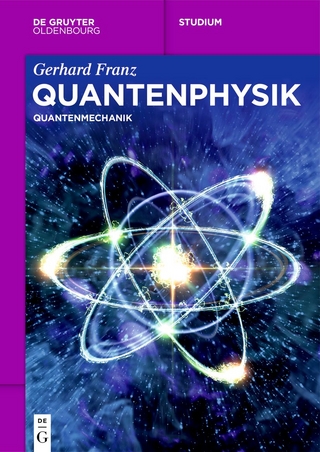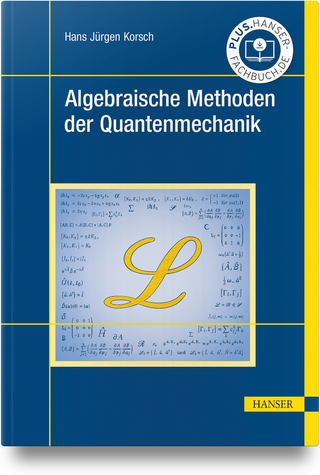
Quantum Field Theory
John Wiley & Sons Inc (Verlag)
978-0-471-49684-7 (ISBN)
New to this edition: Five new chapters, giving an introduction to quantum chromodynamics and the methods used to understand it: in particular, path integrals and the renormalization group. The treatment of electroweak interactions has been revised and updated to take account of more recent experiments.
Franz Mandl is the author of Quantum Field Theory, 2nd Edition, published by Wiley.
Graham Shaw is the author of Quantum Field Theory, 2nd Edition, published by Wiley.
Preface. Notes. 1 Photons and the Electromagnetic Field. 1.1 Particles and Fields. 1.2 The Electromagnetic Field in the Absence of Charges. 1.3 The Electric Dipole Interaction. 1.4 The Electromagnetic Field in the Presence of Charges. 1.5 Appendix: The Schrodinger, Heisenberg and Interaction Pictures. Problems. 2 Lagrangian Field Theory. 2.1 Relativistic Notation. 2.2 Classical Lagrangian Field Theory. 2.3 Quantized Lagrangian Field Theory. 2.4 Symmetries and Conservation Laws. Problems. 3 The Klein Gordon field. 3.1 The Real Klein Gordon Field. 3.2 The Complex Klein Gordon Field. 3.3 Covariant Commutation Relations. 3.4 The Meson Propagator. Problems. 4 The Dirac Field. 4.1 The Number Representation for Fermions. 4.2 The Dirac Equation. 4.3 Second Quantization. 4.4 The Fermion Propagator. 4.5 The Electromagnetic Interaction and Gauge Invariance. Problems. 5 Photons: Covariant Theory. 5.1 The Classical Fields. 5.2 Covariant Quantization. 5.3 The Photon Propagator. Problems. 6 The S-Matrix Expansion. 6.1 Natural Dimensions and Units. 6.2 The S-Matrix Expansion. 6.3 Wick s Theorem. 7 Feynman Diagrams and Rules in QED. 7.1 Feynman Diagrams in Configuration Space. 7.2 Feynman Diagrams in Momentum Space. 7.3 Feynman Rules for QED. 7.4 Leptons. Problems. 8 QED Processes in Lowest Order. 8.1 The Cross-Section. 8.2 Spin Sums. 8.3 Photon Polarization Sums. 8.4 Lepton Pair Production in (e+e-) Collisions. 8.5 Bhabha Scattering. 8.6 Compton Scattering. 8.7 Scattering by an External Field. 8.8 Bremsstrahlung. 8.9 The Infra-Red Divergence. Problems. 9 Radiative Corrections. 9.1 The Second-Order Radiative Corrections of QED. 9.2 The Photon Self-Energy. 9.3 The Electron Self-Energy. 9.4 External Line Renormalization. 9.5 The Vertex Modification. 9.6 Applications. 9.7 The Infra-Red Divergence. 9.8 Higher-Order Radiative Corrections. 9.9 Renomalizability. Problems. 10 Regularization. 10.1 Mathematical Preliminaries. 10.2 Cut-Off Regularization: The Electron Mass Shift. 10.3 Dimensional Regularization. 10.4 Vacuum Polarization. 10.5 The Anomalous Magnetic Moment. Problems. 11 Gauge Theories. 11.1 The Simplest Gauge Theory: QED. 11.2 Quantum Chromodynamics. 11.3 Alternative Interactions?. 11.4 Appendix: Two Gauge Transformation Results. Problems. 12 Field Theory Methods. 12.1 Green Functions. 12.2 Feynman Diagrams and Feynman Rules. 12.3 Relation to S-Matrix Elements. 12.4 Functionals and Grassmann Fields. 12.5 The Generating Functional. Problems. 13 Path Integrals. 13.1 Functional Integration. 13.2 Path Integrals. 13.3 Perturbation Theory. 13.4 Gauge Independent Quantization?. Problems. 14 Quantum Chromodynamics. 14.1 Gluon Fields. 14.2 Including Quarks. 14.3 Perturbation Theory. 14.4 Feynman Rules for QCD. 14.5 Renormalizability of QCD. Problems. 15 Asymptotic Freedom. 15.1 Electron-Positron Annihilation. 15.2 The Renormalization Scheme. 15.3 The Renormalization Group. 15.4 The Strong Coupling Constant. 15.5 Applications. 15.6 Appendix: Some Loop Diagrams in QCD. Problems. 16 Weak Interactions. 16.1 Introduction. 16.2 Leptonic Weak Interactions. 16.3 The Free Vector Boson Field. 16.4 The Feynman Rules for the IVB Theory. 16.5 Decay Rates. 16.6 Applications of the IVB Theory. 16.7 Neutrino Masses. 16.8 Difficulties with the IVB Theory. Problems. 17 A Gauge Theory of Weak Interactions. 17.1 QED Revisited. 17.2 Global Phase Transformations and Conserved Weak Currents. 17.3 The Gauge-Invariant Electro-Weak Interaction. 17.4 Properties of the Gauge Bosons. 17.5 Lepton and Gauge Boson Masses. 18 Spontaneous Symmetry Breaking. 18.1 The Goldstone Model. 18.2 The Higgs Model. 18.3 The Standard Electro-Weak Theory. 19 The Standard Electroweak Theory. 19.1 The Lagrangian Density in the Unitary Gauge. 19.2 Feynman Rules. 19.3 Elastic Neutrino Electron Scattering. 19.4 Electron Positron Annihilation. 19.5 The Higgs Boson. Problems. Appendix A The Dirac Equation. Appendix B Feynman Rules and Formulae for Pertubation Therory. Index.
| Verlagsort | New York |
|---|---|
| Sprache | englisch |
| Maße | 169 x 242 mm |
| Gewicht | 878 g |
| Einbandart | kartoniert |
| Themenwelt | Naturwissenschaften ► Physik / Astronomie ► Quantenphysik |
| Naturwissenschaften ► Physik / Astronomie ► Theoretische Physik | |
| ISBN-10 | 0-471-49684-7 / 0471496847 |
| ISBN-13 | 978-0-471-49684-7 / 9780471496847 |
| Zustand | Neuware |
| Haben Sie eine Frage zum Produkt? |
aus dem Bereich


